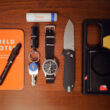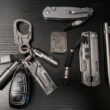When it comes to everyday carry, being prepared is important. That goes for your daily carry, but also for less-normal emergency situations where lives are on the line. And when seconds count, having to made an ad-hoc pack of things to get you through rough times is less than ideal. That’s why EDCers often put together a bug out bag (also known as a bail-out bag or go bag) filled with survival kit essentials that’ll help you keep you and your loved ones safe as you evacuate from disasters either natural or man-made. And even for the less earth-shattering situations, it’s good to have these essential items on hand for say a power outage or getting stranded in your car somewhere inopportune.
There are plenty of guides out there and tons of things you can buy to fill up a pack and call it a bug out bag, but the key thing to understand is that you are not going to want to pack everything save for the kitchen sink when you have to leave quickly. Having a huge bag of a survival kit will slow you down and tire you out, and it might also make you a target for people who weren’t smart enough to pack their own gear in the first place. In this guide, we’ll introduce you to a few essential items that you should consider picking up when putting together a go bag of your own. Just make sure to tailor it all to your own needs, and keep safe out there.

Multi-tool: Leatherman Signal w/ Firestarter
Purchase
Civilian Radio (AM/FM/SW): Tecsun PL-360
Purchase
Power Bank: RAVPower Solar Power Bank
Purchase
Water Purification: Sawyer Squeeze System
Purchase
First Aid: Adventure Medical Kits Hiker Kit
Purchase
Fire Source: UCO Stormproof Match Kit
Purchase
Utensils: Snow Peak Ti Spork
Purchase
Cookware: Esbit Camping Cook Set
Purchase
Emergency Food: Korean Bibimbap
Purchase
Flashlight/Headlamp: Nitecore HC35
Purchase
Sleeping Bag: Klymit KSB 20F
Purchase
Survival Essentials: Suunto MCB Compass
Purchase
Sanitation: Combat Wipes
Purchase
Cordage: Atwood Rope 550 Paracord
Purchase
Fixed Blade: TOPS Knives El Chete
Purchase
Duct Tape: Duck Max Strength
Purchase
Zip Ties: Flurhrt 12″ Heavy Duty
Purchase
Document Holder: Magpul DAKA Document Holder
PurchaseWhat’s in your bug out bag or emergency kit? What do you pack that’s not on our list? Share it with us in the comments below!









